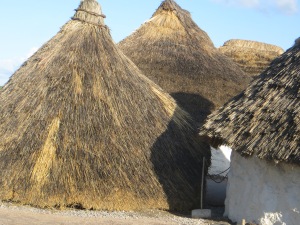One of the pleasures of living in England is the way you can read the history of a landscape through its place names, most of which go back an awful long way.
The earliest names on a map are usually those of the landscape features: the rivers and mountains. I love these names, many of which are of Celtic origin. They sound wild and strange, and a bit like modern Welsh, which is, after all, a Celtic language. These features were named long before the Rmans came.
They make an ancient poem. Colne, Humber, Soar, Trent, Derwent, Aire, Severn, Wharf. These are the rivers.
Scafell, Blencathra, Helvellyn, Pen-y-Ghent, Ingleborough: these are the mountains.
These names, of the bones of the landscape, take me back 3,000 years and more. They roll around in my mouth like a pebble of millstone grit.
The Romans held this northern part of England, but only precariously. Their contribution to English place names is mainly the caster/chester ending to a town name, that denoted a military fort, like Chester, Manchester, Doncaster, and Tadcaster. I have read somewhere that the wyke/wic ending to settlement names is a throwback to the Latin vicus, meaning village. Thus, we have Wyke, Heckmondwike, and Catterick.
After the collapse of the Roman occupation, the names of villages, towns and settlements get more interesting, because they can reveal the development of settlements and waves of occupation and migration during what used to be called The Dark Ages.
First to come were the Saxons and Angles, creating kingdoms like Northumbria (North of the Humber) and Mercia. The earliest Saxon names ended in ington and ingham. These were homesteads established on the major rivers, for rivers were the preferred highways into the country.
In the north, Nottingham on the Trent, Immingham on the Humber, were small settlements of Saxons, and they acted as seeds for the next wave of Anglo-Saxons, who set up villages with the ending ham or ton, from which we get home and town.
The southern part of the country is full of names like this, but they are fairly scattered up here.
In the north, the Vikings and Danes largely (but not entirely) pushed out the Anglo-Saxon English, and their new settlements ended in by, or Thwaite. Slaithwaite is the next village down the valley from us.
The Danes ruled the lands north of the Trent. The frontier of what was called The Danelaw can be roughly traced along the old Roman road of Watling Street, that ran from London to north Wales, by reading the village names. South of Watling Street it is mostly ham and ton, in the north it is mostly by and thwaite. When I was young, I lived in Leicester, which was a border area. I could feel the change from Hoby and Oadby to Nuneaton and Birmingham.
Interestingly, many in Leicester still feel more affinity to their Danelaw neighbouring cities of Lincoln, Nottingham and Derby, than they do to their southern neighbours, like Northampton and Coventry.
When I turn to look at maps of where I live now, in the Colne Valley of Yorkshire, I see a wonderful array of place names that tell of a northern wilderness country, fiercely independent and dou. The names describe fields reclaimed from the moors, flooded land, and just hard, hard work.r

